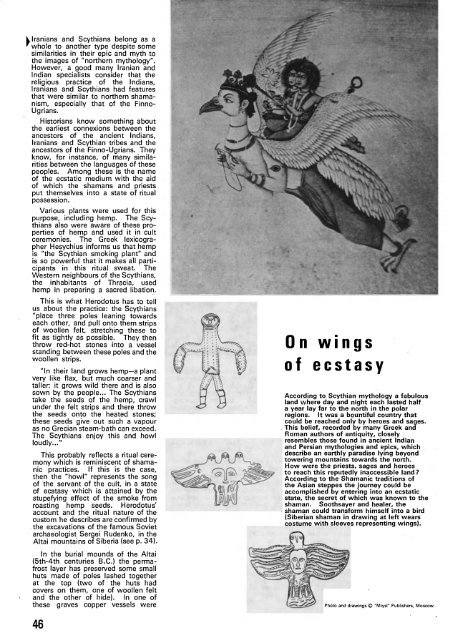The Scythians: nomad goldsmiths of the open steppes; The ...
The Scythians: nomad goldsmiths of the open steppes; The ...
The Scythians: nomad goldsmiths of the open steppes; The ...
Create successful ePaper yourself
Turn your PDF publications into a flip-book with our unique Google optimized e-Paper software.
Jranians and <strong>Scythians</strong> belong as a<br />
whole to ano<strong>the</strong>r type despite some<br />
similarities in <strong>the</strong>ir epic and myth to<br />
<strong>the</strong> images <strong>of</strong> "nor<strong>the</strong>rn mythology".<br />
However, a good many Iranian and<br />
Indian specialists consider that <strong>the</strong><br />
religious practice <strong>of</strong> <strong>the</strong> Indians,<br />
Iranians and <strong>Scythians</strong> had features<br />
that were similar to nor<strong>the</strong>rn shama¬<br />
nism, especially that <strong>of</strong> <strong>the</strong> Finno-<br />
Ugrians.<br />
Historians know something about<br />
<strong>the</strong> earliest connexions between <strong>the</strong><br />
ancestors <strong>of</strong> <strong>the</strong> ancient Indians,<br />
Iranians and Scythian tribes and <strong>the</strong><br />
ancestors <strong>of</strong> <strong>the</strong> Finno-Ugrians. <strong>The</strong>y<br />
know, for instance, <strong>of</strong> many simila¬<br />
rities between <strong>the</strong> languages <strong>of</strong> <strong>the</strong>se<br />
peoples. Among <strong>the</strong>se is <strong>the</strong> name<br />
<strong>of</strong> <strong>the</strong> ecstatic medium with <strong>the</strong> aid<br />
<strong>of</strong> which <strong>the</strong> shamans and priests<br />
put <strong>the</strong>mselves into a state <strong>of</strong> ritual<br />
possession.<br />
Various plants were used for this<br />
purpose, including hemp. <strong>The</strong> Scy¬<br />
thians also were aware <strong>of</strong> <strong>the</strong>se pro¬<br />
perties <strong>of</strong> hemp and used it in cult<br />
ceremonies. <strong>The</strong> Greek lexicogra¬<br />
pher Hesychius informs us that hemp<br />
is "<strong>the</strong> Scythian smoking plant" and<br />
is so powerful that it makes all parti¬<br />
cipants in this ritual sweat. <strong>The</strong><br />
Western neighbours <strong>of</strong> <strong>the</strong> <strong>Scythians</strong>,<br />
<strong>the</strong> inhabitants <strong>of</strong> Thracia, used<br />
hemp in preparing a sacred libation.<br />
This is what Herodotus has to tell<br />
us about <strong>the</strong> practice: <strong>the</strong> <strong>Scythians</strong><br />
"place three poles leaning towards<br />
each o<strong>the</strong>r, and pull onto <strong>the</strong>m strips<br />
<strong>of</strong> woollen felt, stretching <strong>the</strong>se to<br />
fit as tightly as possible. <strong>The</strong>y <strong>the</strong>n<br />
throw red-hot stones into a vessel<br />
standing between <strong>the</strong>se poles and <strong>the</strong><br />
woollen strips.<br />
"In <strong>the</strong>ir land grows hempa plant<br />
very like flax, but much coarser and<br />
taller; it grows wild <strong>the</strong>re and is also<br />
sown by <strong>the</strong> people... <strong>The</strong> <strong>Scythians</strong><br />
take <strong>the</strong> seeds <strong>of</strong> <strong>the</strong> hemp, crawl<br />
under <strong>the</strong> felt strips and <strong>the</strong>re throw<br />
<strong>the</strong> seeds onto <strong>the</strong> heated stones;<br />
<strong>the</strong>se seeds give out such a vapour<br />
as no Grecian steam-bath can exceed.<br />
<strong>The</strong> <strong>Scythians</strong> enjoy this and howl<br />
loudly..."<br />
This probably reflects a ritual cere¬<br />
mony which is reminiscent <strong>of</strong> shamanic<br />
practices. If this is <strong>the</strong> case,<br />
<strong>the</strong>n <strong>the</strong> "howl" represents <strong>the</strong> song<br />
<strong>of</strong> <strong>the</strong> servant <strong>of</strong> <strong>the</strong> cult, in a state<br />
<strong>of</strong> ecstasy which is attained by <strong>the</strong><br />
stupefying effect <strong>of</strong> <strong>the</strong> smoke from<br />
roasting hemp seeds. Herodotus'<br />
account and <strong>the</strong> ritual nature <strong>of</strong> <strong>the</strong><br />
custom he describes are confirmed by<br />
<strong>the</strong> excavations <strong>of</strong> <strong>the</strong> famous Soviet<br />
archaeologist Sergei Rudenko, in <strong>the</strong><br />
Altai mountains <strong>of</strong> Siberia (see p. 34).<br />
In <strong>the</strong> burial mounds <strong>of</strong> <strong>the</strong> Altai<br />
(5th-4th centuries B.C.) <strong>the</strong> perma¬<br />
frost layer has preserved some small<br />
huts made <strong>of</strong> poles lashed toge<strong>the</strong>r<br />
at <strong>the</strong> top (two <strong>of</strong> <strong>the</strong> huts had<br />
covers on <strong>the</strong>m, one <strong>of</strong> woollen felt<br />
and <strong>the</strong> o<strong>the</strong>r <strong>of</strong> hide). In one <strong>of</strong><br />
<strong>the</strong>se graves copper vessels were<br />
46<br />
On wings<br />
<strong>of</strong> ecstasy<br />
According to Scythian mythology a fabulous<br />
land where day and night each lasted half<br />
a year lay far to <strong>the</strong> north in <strong>the</strong> polar<br />
regions. It was a bountiful country that<br />
could be reached only by heroes and sages.<br />
This belief, recorded by many Greek and<br />
Roman authors <strong>of</strong> antiquity, closely<br />
resembles those found in ancient Indian<br />
and Persian mythologies and epics, which<br />
describe an earthly paradise lying beyond<br />
towering mountains towards <strong>the</strong> north.<br />
How were <strong>the</strong> priests, sages and heroes<br />
to reach this reputedly inaccessible land?<br />
According to <strong>the</strong> Shamanic traditions <strong>of</strong><br />
<strong>the</strong> Asian <strong>steppes</strong> <strong>the</strong> journey could be<br />
accomplished by entering into an ecstatic<br />
state, <strong>the</strong> secret <strong>of</strong> which was known to <strong>the</strong><br />
shaman. Soothsayer and healer, <strong>the</strong><br />
shaman could transform himself into a bird<br />
(Siberian shaman in drawing at left wears<br />
costume with sleeves representing wings).<br />
Photo and drawings © "Miysl" Publishers. Moscow.

















